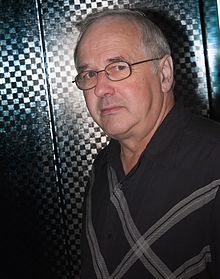George Sawatzky
George Sawatzky | |
|---|---|
 | |
| Alma mater | |
| Occupation | University teacher |
| Awards |
|
| Scientific career | |
| Thesis | Some properties of ferrimagnetic spinels and their determination with the Mössbauer effect (1969) |
| Website | phas |
George Albert Sawatzky
Education and career
George A. Sawatzky earned in 1965 his B.S. in physics with Honours from the
Research
Since 1966 Sawatzky has published in scientific journals more than 380 articles. His papers have been cited more than 28,000 times according to ISI Thomson. He has published 77 papers with more than 100 citations and his so-called H index (Hirsch index is 87). According to CIFAR, his research "focuses on: electronic structure of nanostructured strongly correlated materials, such as magnetic materials, high temperature superconductors, and materials for electronics applications; the development and use of various synchrotron-based spectroscopic methods to study such systems; as well as theoretical methods to describe the relationship between the physical properties and the chemical composition, structure and morphology."[6]
Sawatzky has made major contribution to the understanding of transition metal oxides (such as gamma and alpha Fe2O3 and Fe3O4) and more generally correlated electron systems and also to the development of spectroscopic techniques suited to study the electronic structure of these systems. He generated some of the earliest ideas about effects such as transferred and, especially, supertransfered hyperfine fields and developed the theory to describe these in terms of the covalency of the Fe–O bonds. He pioneered the cluster approach now used in understanding the Fe-O-Fe bond angle, the superexchange interaction, and the supertransferred hyperfine fields, as well as the electronic structure of strongly correlated systems like the high temperature superconductors and colossal magneto resistance materials.
In the early 1970s Sawatzky and his co-workers used transport measurements and various resonant techniques like
In the 1980s Sawatzky showed how photoelectron and Bremsstrahlung isochromat spectroscopy could be used to determine the Hubbard U in magnetic impurity systems and rare earths. His group was the first to directly observe the exchange splitting of the Mn3d impurity states in the Kondo-like systems containing Mn impurities. His group also showed that the band gap in NiO was of a charge transfer type and not a Mott Hubbard type. Together with Jan Zaanen and James W. Allen, Sawatzky developed the ZSA model (which became widely used) for describing the basics of the electronic structure of 3d transition metal oxides.
In the mid 1980s Sawatzky was introduced to X-ray absorption spectroscopy and the use of synchrotron radiation by John Fuggle. Sawatzky and his group started a long and very productive study of X-ray spectroscopies which form the basis for widely used spectroscopies at present. Over the past 3 decades he has led important research in theories and experiments related to strongly correlated materials.
Honours and awards
- 1990 Elected Member of the Royal Netherlands Academy of Arts and Sciences (KNAW)[8]
- 1996 NWO-Spinoza award (Netherlands Organization for Scientific Research)[9][10]
- 1996 (and subsequent years) ISI list of highly cited
- 1997 Nieuwsblad van het Noorden prize
- 2002 Knight in the order of the Dutch Lion
- 2002 Elected Fellow of the Royal Society of Canada
- 2003 Elected Fellow of the American Physical Society
- 2007 RSC Henry Marshall Tory Medal
- 2008 Elected Fellow of the Royal Society of London
- 2011 IFW Dresden Leibnitz medal
Editorial Boards
- 1992–1997 Editor of Journal of Physics and Chemistry of Solids
- 1994–2001 Journal of Electron Spectroscopy and Related Phenomena (Advisory Editorial Board)
- 2006–2010 Associate editor Europhysics Letters
References
- ^ a b NWO. "Prof. dr. G.A. (George) Sawatzky" (in Dutch).
- arXiv:cond-mat/0011300.
- ISBN 0750302569.
- ISBN 9781420008425.
- ^ "George Sawatzky". University of British Columbia.
- ^ a b CIFAR. "George A. Sawatzky".
- ^ "Max Planck Institute". Max Planck Institute.
- ^ "George Sawatzky". Royal Netherlands Academy of Arts and Sciences. Archived from the original on 8 August 2020.
- ^ Rijksuniversiteit Groningen. "Spinoza Prizes".
- ^ "NWO Spinoza Prize 1996". Netherlands Organisation for Scientific Research. 11 September 2014. Archived from the original on 2 November 2020. Retrieved 30 January 2016.
